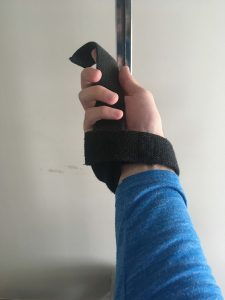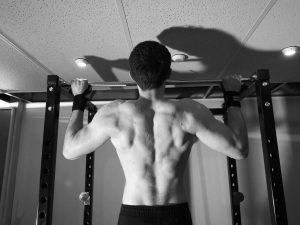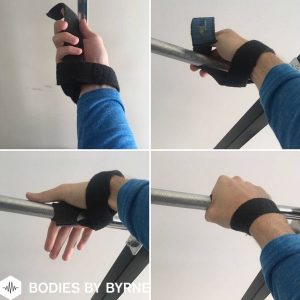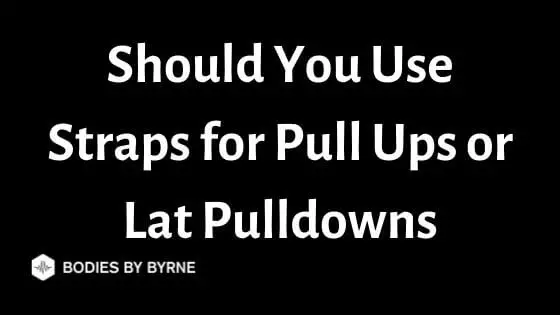—
When starting out in the gym everything is a new experience and most people won’t have any real idea of what they are supposed to be doing. It’s quite a steep learning curve when it comes to exercise selection alone, due to the range of equipment and muscles you need to work.
Therefore it’s always best to start with the basics and just learn to use good form and get strong in the heavy compound lifts (squat, deadlift, overhead press, chest press, row, pull up, dip lunge) first. Doing this alone will make up 80%-90% of your progress over 1-2 years of training.
Once you start to adopt the lifestyle a bit more though and become advanced in your training then it’s natural to look into more advanced techniques, equipment and accessories.
When it comes to training accessories there are a range of things to choose from (some good, some not so good) that can aid you in building muscle. One of the best training accessories you can purchase in my opinion is a set of lifting straps.
Should you use straps for pull ups or lat pulldowns? If grip strength is not your highest training priority then you should certainly use straps for pull ups and pulldowns. These will ensure that your grip strength is not a limiting factor and you can therefore train your back muscles with the most weight which will in turn lead to more muscle growth.
I’ve mentioned these before as an essential accessory for those looking to build muscle and see them as a game changer for hardgainers or simply those who don’t have good genetics for lifting. The only issue is that people debate whether they are beneficial or a training crutch, especially when it comes to heavy pulls like rows, deadlifts, pulldowns and pull ups.
If you are on the fence about whether or not you feel that lifting straps are a beneficial accessory then I’m not going to try and pitch them to you. This article is going to specifically outline why it could be beneficial for you to use straps when doing pull ups or lat pulldowns.
Table of Contents
What Are Lifting Straps

Lifting straps are a weightlifting accessory that you can use to support your grip, particularly when performing heavy pulling exercises.
A lifting strap is looped around your wrist in a half figure 8 position like the image above and then wrapped around the bar multiple times to create a harness between your wrist and the bar. It’s a similar process to tying a knot around something to secure it.
People tend to have very strong opinions on lifting straps depending on what your training philosophy is.
For those that are focused on functional strength (I very much dislike many of the training “terms” that exist today), they see a reliance on training aids as something that will cause a weak link in your kinetic chain.
Now I can agree with this to an extent. If you can’t perform something without the use of an external aid, then using it and adding a load is a recipe for injury. This is because a range of external aids often allow you to perform a lift at 10%-20% more than what you can currently do or are used to.
A powerlifting suit for example generates elastic energy to assist you in force production, now these are ok for powerlifters with years of training who have built up muscular, joint and tendon strength however a beginner attempting this will lift significantly more than their body is used to and greatly increase the risk of injury.
That Is logic I can certainly appreciate but most functional trainers take it way too far and end up working stabilizing muscle groups in preference of the larger muscle groups because it’s “functional”. I don’t even know what that term means anymore.
There are also hardcore lifters who train purely strength at their bodies capacity. If they can’t squat heavy because their midsection can’t support the weight then the focus on bringing up their core muscles. If they can’t deadlift heavy because their grip gives out too soon then they focus on grip strength.
That is a good mentality to have when it comes to working within your bodies capabilities however it’s just the case that some people have significant disadvantages based on a range of factors including genetics.
This is where the pro lifting strap users come in. If your grip is a weak link in bringing up your deadlift, one of the best full body exercises you can do, then the obvious solution is to eliminate that weak link completely to continue to progress and this is what lifting straps do.
Before reading on, you’ll see from the pictures that I’m using some basic lifting straps at the minute but the best set I’ve ever owned is the Shiek padded lifting straps. I can’t recommend these enough in terms of comfort and value.
Should You Use Straps for Pull Ups or Lat Pulldowns

While the deadlift causes the most debate when it comes to whether or not you should use lifting straps, pull ups and lat pulldowns come in at a close second.
Even though they are both similar movements there are again different opinions regarding whether or not you should use lifting straps for each one. To be honest I too have a difference of opinion for each one with the benefits and drawbacks of each so we’ll look into them separately.
Should You Use Straps for Pull Ups
Pull ups are one of the best exercises that you can include in any muscle or strength building routine. They are difficult, particularly for beginners however the benefits are huge. The most obvious one is being able to control your own body weight during a pulling exercise.
Mastering body weight should always be your number one priority before ever adding an external load into the equation. This is true for most body parts whether it be push ups, squats or pull ups. The reason for this is to not only learn the correct form and motor unit recruitment but to also ensure you can engage the smaller stabilizing muscle groups.
When talking pull ups we are specifically referring to an overhand grip that is shoulder width or greater. A chin up using an underhand grip brings the bicep into activation to a much greater degree and therefore I don’t feel grip strength should ever be an issue with chin ups.
If you don’t know the difference between a pull up and chin up then you can check out my article on it here.
Pull ups on the other hand use much less bicep engagement, particularly the wider your grip is and therefore you might find that your grip gives out on pull ups much sooner than your back muscles do.
When using straps for pull ups I think it comes down to whether you are doing bodyweight pull ups or weighted pull ups (a dumbbell between your legs or using a dipping belt to add weight plates).
The reason for this differentiation is because similar to what I’ve mentioned earlier, you should be mastering your own body weight first before looking to add an external load.

This might sound contradictory to the advice of assisting grip strength so that it is not a limiting factor in back growth but everyone should have a base level of strength. If you don’t have the grip strength to pull your own body weight repeatedly then this is a glaring strength weakness that you rectify.
This is not contradictory advice and is completely different from someone that is trying to pull 500lbs from the floor! And inability to hang from a bar and perform pull ups is definitely a weakness so in this scenario you shouldn’t be trying to assist the movement
Once you’ve got this basic level of strength and you are moving on the weighted pull ups then this is when you can look to start using straps. I’d still try to go as long as possible without using them and save them for your top set weight but now that you have an acceptable level of grip strength then it’s important to not let your grip become a limiting factor in back development.
Should You Use Straps for Lat Pulldowns
In general I’d say that lat pulldowns are a lot less controversial when it comes to strap use because they are seen as more of an isolation exercise to specifically target a muscle group. Compound movements utilize multiple muscle groups and this is where the question of functional strength comes in but for isolation exercises it’s much less of an issue.
As you are specifically targeting your back muscles in a lat pulldown the focus is more on muscle hypertrophy by isolating the lat muscles and performing higher reps in the 8-12 range (though some go as high as 15 reps).
With a pull up there are many that are training this movement for strength and not just muscle growth because of the carryover it has to other lifts and are less inclined to use straps for this reason, myself included.
With a lat pulldown though you want to use as much weight possible to fatigue the back muscles. Getting locked in underneath the leg pads allows you to create maximum muscle tension which is essential for muscle growth but the back muscles do not fatigue easily.
Therefore lifting straps are commonly used on lat pulldowns in order to isolate the lats and lift as much weight as possible for as many reps as possible. As an isolation exercise (yes I do class it as that despite working a large muscle group) I can’t see any reason not to use lifting straps.
This isn’t an exercise that lends itself well to improving grip strength so I can’t see any logical reasons not to use lifting straps for this. You can lift as much weight as your strength will allow without having to worry about your grip strength giving out. It’s therefore ideal for muscle hypertrophy.
How to Use Lifting Straps
Lifting straps are incredibly easy and intuitive to use and the results are immediate for such a simple and cheap accessory.
The best pair of lifting straps that I’ve ever owned were £20/$25 made by Schiek and had a padded wrist that also had the secondary function of acting as a wrist wrap for joint support on heavy presses. I currently use a basic set though which does the job when it comes to pulling.
To use a lifting strap you simply create a loop around your wrist creating the bottom section of a figure 8. You then wrap the lengthened end around the 3-4 times (depending on the girth of the bar) and then grip the bar where the strap covers it.

This technique above will essentially lock your wrist to the bar so your actual grip will still be required, just to a much lesser degree.
Why Should You Use Lifting Straps
The simple reason for why you should use lifting straps is for a lot of people your grip strength will be a major weak link when it comes to heavy pulling exercises, primarily aimed at the back.
I personally have long arms which give great leverage for heavy pulling but the issue is that having a small wrist joint means my grip held me back for a number of years.
I remember working up to 50kg/110lb dumbbell rows and shrugs at 18/19 years of age as they were the heaviest dumbbells in the gym. While I had the muscular strength to lift the weight my grip would give out every time at around the 6 rep point.
I tried using a hand towel and blue roll (used to wipe down equipment) to stop the bars from spinning and slipping but even with repeated attempts my grip strength never seemed to match it and this is the case for a lot of people.
Your back muscles are amongst the largest in your body and on exercises like the deadlift you are engaging the majority of them. Therefore it stands to reason that these muscles are significantly stronger than your smaller forearm muscles.
To truly work your back for maximum strength and hypertrophy I feel that at some point, you will need to use straps to push your limits and exhaust your back muscles. This doesn’t however mean that you should become reliant on them though.
When using straps you should only use them for your heaviest working sets or your top set. This is to ensure that you are still bringing up your grip strength over time and not underworking your forearms during these types of exercises.
What Next
If you are looking to make changes to your physique by either losing body fat, building muscle or looking to maintain a lean physique then sign up to my weekly newsletter below. Each week I send out actionable tips to help you lose that extra 1lb of fat or build that extra 0.5lb of muscle mass on a weekly basis.
If you sign up now you’ll also receive my 28 day body recomp program completely Free. This ebook will be sent straight to your inbox and will provide an intense 28 day program aimed at helping you lose up to 8lbs of body fat whilst also building 2lb-4lb of lean muscle mass in just 4 weeks.
Don’t worry if you’re not ready for an intense program just yet, my weekly newsletter will give smaller tips that when implemented daily, will stack up over time and see you transform your body with seemingly minimal effort!
